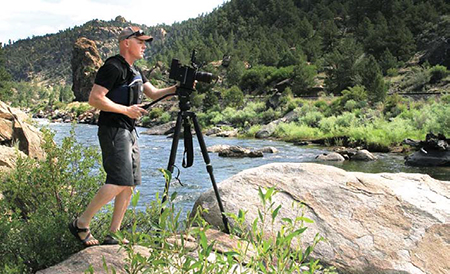Miller Camera Support Shoots the Rapids

Nathan WardSALIDA, COLO.—As a writer, photographer and videographer, I spend my life capturing moments. I’m an adventurous person with a strong interest in humanitarian organizations and established Grit & Thistle Film Company one year ago with fellow entrepreneur Carlin Walsh. Together, we create a mix of documentaries, short form television, promotional and marketing videos that capture environmental and social issues for charitable organizations.
One of these is Veterans Expeditions, a non-profit that aims to build a community among U.S. veterans by taking them on wilderness trips that serve to remind them of the land that they fought so hard to preserve.
To help spread awareness for this cause, we were tasked with shooting a mini documentary, “The Land Defended: Veterans Expeditions and the Browns Canyon,” which examines the lives of three veterans as they embark on a whitewater rafting excursion through the Browns Canyon of the Arkansas River in Colorado.
BATTLING NATURE ALL THE WAY
To combat the rapids, our cinematography team needed to use top-notch equipment that provided the right feel and strength to stand steady against the waves and other challenges nature sent our way. Prior experience with several lines of camera support gear led us to Miller Camera Support, LLC and that company’s Compass 20 Solo 75 three-stage carbon fiber tripod system.
While shooting, we ran into Class IV whitewater—and the waves, possible rocks and drops that it entails—so it was a huge comfort to have Miller’s Compass 20 next to us in the raft and to be able to jump out into the water and wade to shore whenever a suitable shooting location presented itself.
The Compass 20 can be set up and ready to go in less than one minute and this speed element was essential throughout the shoot, as we needed to be all set and ready to capture footage of the rafts behind us as they quickly barreled down the rapids.
I’ve worked with a lot of tripod companies, both as a still photographer and videographer. Most of the tripods I’ve used are not sturdy enough to endure the types of projects we shoot. We do a lot of work in the back country, so we need a system light enough to carry in a backpack to the top of a mountain, but robust enough to survive a ski shoot in a frigid climate with treacherous landscape. We get that kind of versatility with Miller.
The professional video industry's #1 source for news, trends and product and tech information. Sign up below.
DUAL FOOT SYSTEM MAKES A DIFFERENCE
Additionally, the Miller tripod’s sturdy leg angle locks and spike/rubber feet allowed our crew to deal with adverse climactic conditions. Whether we were shooting in the sand banks alongside the river, in the river itself, or setting up on a big boulder overlooking the river, the Compass 20 provided the support and stability we needed. Its rubber feet were ideal for shooting on rocks and the spikes were perfect in sand or mud. Though these may seem to be little perks, they add up to be big advantages and helped to make our shooting expedition a success.
Nathan Ward is an established writer, photographer and videographer and co-founder of Grit & Thistle Film Co. He may be contacted atnathan@gritandthistle.com.
For additional information, contact Miller Camera Support LLC at 973-857-8300 or visitwww.millertripods.com.
